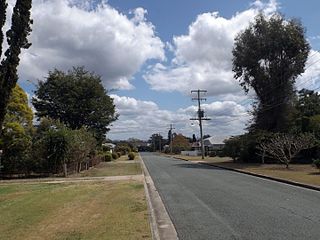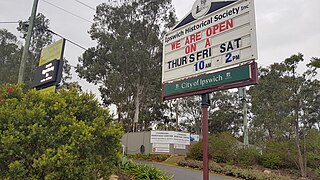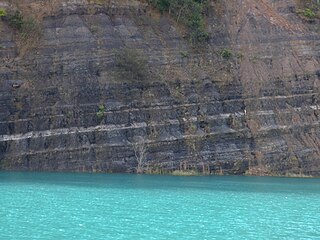The Surat Basin is a geological basin in eastern Australia. It is part of the Great Artesian Basin drainage basin of Australia. The Surat Basin extends across an area of 270,000 square kilometres and the southern third of the basin occupies a large part of northern New South Wales, the remainder is in Queensland. It comprises Jurassic through to Cretaceous aged sediments derived from Triassic and Permian arc rocks of the Hunter-Bowen orogeny. Towns situated above the basin, once dominated by agriculture, are experiencing a boom as mines and infrastructure in the area are expanded.

Rhoetosaurus, named after Rhoetus, a titan in Greek mythology, is a genus of sauropod dinosaur from the Jurassic (Oxfordian) Walloon Coal Measures of what is now eastern Australia. Rhoetosaurus is estimated to have been about 15 metres (49 ft) long, weighing about 9 tonnes. Subsequent authors have sometimes misspelled the name: Rhaetosaurus ; Rheteosaurus.

A fossil track or ichnite is a fossilized footprint. This is a type of trace fossil. A fossil trackway is a sequence of fossil tracks left by a single organism. Over the years, many ichnites have been found, around the world, giving important clues about the behaviour of the animals that made them. For instance, multiple ichnites of a single species, close together, suggest 'herd' or 'pack' behaviour of that species.

Ebbw Vale is a suburb of Ipswich in the City of Ipswich, Queensland, Australia. In the 2016 census, Ebbw Vale had a population of 508 people. Ebbw Vale is a Welsh name, so the ‘w’ is pronounced with an ‘oo’ sound.

New Chum is a suburb in the City of Ipswich, Queensland, Australia. In the 2016 census, New Chum had a population of 0 people.
The Marree Subgroup, previously described as Maree Formation and Marree Formation, is a geological subgroup in the Eromanga Basin of South Australia whose strata date back to the Aptian. The subgroup was first described as a formation by Forbes in 1966. Dinosaur remains are among the fossils that have been recovered from the formation.
The Blackstone Formation is a geologic formation of the Ipswich Coal Measures Group in southeastern Queensland, Australia, dating to the Carnian to Norian stages of the Late Triassic. The shales, siltstones, coal and tuffs were deposited in a lacustrine environment. The Blackstone Formation contains the Denmark Hill Insect Bed.
The Chacarilla Formation is an Oxfordian to Early Cretaceous geologic formation of the Tarapacá Basin in northern Chile, close to the border with Bolivia. The marine and fluvial formation preserves several dinosaur trackways and has been declared a Natural Sanctuary in 2004.
The East Berlin Formation is an Early Jurassic geological formation in New England, United States. Dinosaur footprints and trackways are abundant in this formation. These tracks include Eubrontes, Anchisauripus, and Anomoepus. Several museums, parks, and tourist attractions are based around the East Berlin Formation's dinosaur tracks, including Dinosaur State Park in Rocky Hill, Connecticut and Powder Hill Dinosaur Park in Middlefield, Connecticut.
The Higueruelas (Spanish) or Higuerueles Formation (Catalan) is a Tithonian geologic formation in the Teruel and Valencia provinces of Spain. Fossil sauropod tracks have been reported from the formation.

The Precipice Sandstone an Early Jurassic geologic formation of the Surat Basin in New South Wales and Queensland, eastern Australia, know due to the presence of abundant vertebrate remains & tracks. This unit includes the previously described Razorback beds. This unit represents a major, almost primary, source of hydrocarbons in the region, with a Potential CO2 reservoir of up to 70m. It was deposited on top of older sediments, like Bowen Basin units, in an unconformable manner, resting along the eastern basin margin and the Back Creek Group in the southern Comet Platform, while in other areas it directly overlies the Triassic Moolayember Formation & Callide Coal Measures, being deposited in a comparatively stable basin. Isopach maps of the Precipice Sandstone indicate two distinct areas of sediment accumulation, suggesting two separate depocentres filled from different source regions during the Sinemurian, with the Thomson orogeny and New England Orogen hinterlands as possible ones. This unit represented a fluvial-palustrine-lacustrine braided channel north-flowing succession, that seem to have debouch into a shallow restricted tidal/wave influenced marine embayment, marked at areas like Woleebee Creek. Paleoenvironment-wise, it represents a hinterland rich in vegetation, hinting at wet environments like swamps, where agglutinated foraminifera suggests marine flooding and drier conditions or the encroachment of seawater onto coastal areas.
The Baños del Flaco Formation is a Late Jurassic to Early Cretaceous (Tithonian to Berriasian geologic formation in central Chile. The formation comprises limestones and sandstones deposited in a shallow marine to fluvial environment. Fossil ornithopod tracks have been reported from the formation.
Geologically the Australian state of New South Wales consists of seven main regions: Lachlan Fold Belt, the Hunter-Bowen Orogeny or New England Orogen (NEO), the Delamerian Orogeny, the Clarence Moreton Basin, the Great Artesian Basin, the Sydney Basin, and the Murray Basin.

The geology of Queensland can be subdivided into several regions with different histories. Along the east coast is a complex of Palaezoic to Cainozoic rocks while much of the rest of the state is covered by Cretaceous and Cainozoic rocks. A Precambrian basement is found in the north west and Cape York regions. The Thomson Orogen occurs in the central and southern parts of Queensland, but is mostly covered by younger basins.

The Clarence Moreton Basin is a Mesozoic sedimentary basin on the easternmost part of the Australian continent. It is located in the far north east of the state of New South Wales around Lismore and Grafton and in the south east corner of Queensland. It is the part of the Great Artesian Basin that extends to the east coast in Australia's central eastern lowlands.
The Areado Group is a Late Jurassic to Early Cretaceous geologic group in southeastern Brazil. The group was defined by Cardoso in 1968.
The Minnes Group, originally named the Minnes Formation, is a geologic unit of latest Jurassic to earliest Cretaceous age in the Western Canada Sedimentary Basin. It is present in the northern foothills of the Canadian Rockies and the adjacent plains in northeastern British Columbia and west-central Alberta. Its strata include natural gas reservoirs and minor coal deposits. Fossil dinosaur tracks have been described from one of its formations.
The Evergreen Formation is a Pliensbachian to Toarcian geologic formation of the Surat Basin in New South Wales and Queensland, eastern Australia. Traditionally it has been considered to be a unit whose age has been calculated in between the Pliensbachian and Toarcian stages of the Early Jurassic, with some layers suggested to reach the Aalenian stage of the Middle Jurassic, yet modern data has found that an Early Pliensbachian to Latest Toarcian age is more possible. The formation was named due to the "Evergreen Shales", defined with a lower unit, the Boxvale Sandstone, and a partially coeval, partially younger upper unit, the Westgrove Ironstone Member. This unit overlies the Hettangian-Sinemurian Precipice Sandstone, as well several informal units such as the Nogo Beds, and Narayen beds, as well Torsdale Volcanics. This unit likely was deposited in a massive lacustrine body with possible marine environment influences.
The Mutdapilly fossil locality is a fossil site in the geological formation Walloon Coal Measures of Queensland, Australia. It contains fossilized impressions of flora dating back to the Middle Jurassic.
The Kootenay Group, originally called the Kootenay Formation, is a geologic unit of latest Jurassic to earliest Cretaceous age in the Western Canada Sedimentary Basin that is present in the southern and central Canadian Rockies and foothills. It includes economically important deposits of high-rank bituminous and semi-anthracite coal, as well as plant fossils and dinosaur trackways.







